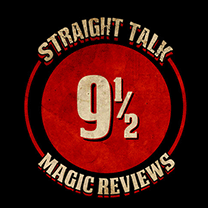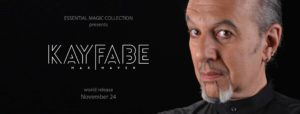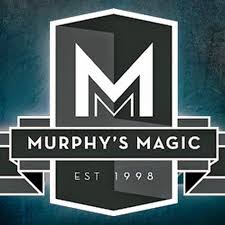 Kayfabe is the Essential Magic Collection’s 4 DVD project featuring legendary mentalist and magician Max Maven. Consistent with EMC’s prior projects, this one too is fantastic. So, what is Kayfabe? It is, believe it or not, an American entertainment wrestling term for keeping secrets. In this project, Maven “breaks” Kayfabe and reveals the secrets behind many of his tricks, some of the secrets having been kept for 40 years. The entire project consists of over 9 hours of material. Each DVD has subtitles in English, French, Japanese or Spanish.
Kayfabe is the Essential Magic Collection’s 4 DVD project featuring legendary mentalist and magician Max Maven. Consistent with EMC’s prior projects, this one too is fantastic. So, what is Kayfabe? It is, believe it or not, an American entertainment wrestling term for keeping secrets. In this project, Maven “breaks” Kayfabe and reveals the secrets behind many of his tricks, some of the secrets having been kept for 40 years. The entire project consists of over 9 hours of material. Each DVD has subtitles in English, French, Japanese or Spanish.
First off, the DVD’s are excellently produced and the menus are well-organized. The 4 DVD’s come in a very nice and cool folding black box. EMC and Luis De Matos knows how to put out a top-notch product and hits it out of the park every time. In this review, I am going to critique each DVD individually. So, if you visit this link today, it may grow as I add reviews of the other three DVD’s.
Let’s start with the first DVD, labelled “Spring.”
 The Spring DVD consists of Maven performing in a lecture hall someplace in Portugal to an English speaking Portuguese audience. Maven stands on the stage and the audience sits in staggered and elevated seats so they mostly look down at Maven. The multiple camera angles vary from the floor with Maven to the highest level of audience seating.
The Spring DVD consists of Maven performing in a lecture hall someplace in Portugal to an English speaking Portuguese audience. Maven stands on the stage and the audience sits in staggered and elevated seats so they mostly look down at Maven. The multiple camera angles vary from the floor with Maven to the highest level of audience seating.
On the Spring DVD, Maven performs 4 routines (Cognomen, Spy Story, Rorrim and About Face) to the audience and then explains his presentation in studio. Maven tips the methods, his nuances and subtleties. During the explanation section of each routine, you learn that Maven is very knowledgeable about the history of magic and mentalism and obsessively credits those that have come before us.
The first routine performed (8 minutes) and taught (20 minutes) is Cognomen. At its core, Cognomen is a billet routine in which several spectators write down the name of a world famous person and then they each fold the billet so the name cannot be seen. Another spectator mixes the billets and returns them to Maven and another one takes a billet from Maven that contains a name. Only the spectator looks at the billet, but Maven is able to read the spectator’s mind and commits his prediction by writing the name down on a large piece of paper so that the audience can see it was “JOHN LENNON” a few seconds after the spectator discloses the name that was hidden on the folded billet. If you are an experienced mentalist, magician or reader of related literature, the methods behind the routines on Spring may not be new to you, but Maven’s very deliberate and articulate performances are excellent and worth watching. If you don’t know his persona or character, you should.
Spy Story is the second routine (a 12 minute routine that is taught over the course of 40 minutes) in which Maven, with audience participation, creates a mysterious spy story in which various members of the audience contribute answers to certain questions such as a time, a place somewhere in the world, acode name and an amount of money – all of which are made up on the spot. During the routine, Maven writes down the different answers to refer back to later, if needed. At the end of the routine, Maven taken out his wallet and from inside a zippered pocket he removed a sealed envelope. Inside the envelope is a note that miraculously tells the spy story using the exact details that the audience made up on the spot just moments before.
The third routine on Spring is Rorrim (“mirror” backwards) in which Maven pretends that he is an audience member’s doplpeganger. The spectator selects two cards from a deck of cards that he cuts behind his back and places each card in different pockets. Then Maven repeats the actions with an imaginary deck and pretends to take out two cards and put them in his pockets. Then Maven calls out his imaginary cards from the pockets he pretended to put them each into. Amazingly, when the spectator takes out the real cards from the designated pockets, they match the cards that Maven called out. Then, Maven reaches into his pockets again and pulls out two jumbo cards that match the spectator’s cards. This routine, unlike the two prior routines, could be performed for an audience of 1 or to an arena. It is astoundingly impressive. The performance is 5 minutes and the explanation takes 8 minutes.
The final mentalism routine on Spring is named About Face. The performance take 9 minutes and the explanation 9 minutes. This is a psychometry routine in which four audience members draw pictures of faces on pieces of paper, mix them up and Maven is able to connect each picture to each spectator. The routine can be very funny based upon the pictures drawn and the interchange between the selected spectators and the performer.
At the end of Spring there is an amazing 34 minute interview of Maven conducted by De Matos in which Maven discusses his life, his experiences, the path he took and how older and generous magicians mentored him and fed his obsession with magic and mentalism.
Summer is the second DVD in Kayfabe. In this DVD, Maven explores magic and mentalism with a deck of cards. What is front and center with Maven’s approach to his tricks is that he is not fearful to make mistakes or not get it 100% correct 100% of the time. Maven has the confidence to explore card magic that is not self-working and not done in 90 seconds start to finish. In fact, his card tricks are more like full routines that last several minutes, require undivided attention of his spectator’s and tell a story. With this approach, Maven connects with his spectator and the presentation becomes more intimate and personal. Maven spends some time teaching the classic force and the clocking technique. He gives credit to the legendary Harry Lorayne and demonstrates the method.
During the interview segment in Summer, Maven gets very personal and discusses his evolution from Phil Goldstein to Max Maven. Like the first interview segment, this one was compelling and left me wanting to watch more.
Summer is the second DVD in Kayfabe. In this DVD, Maven explores magic and mentalism with a deck of cards. What is front and center with Maven’s approach to his tricks is that he is not fearful to make mistakes or not get it 100% correct 100% of the time. Maven has the confidence to explore card magic that is not self-working and not done in 90 seconds start to finish. In fact, his card tricks are more like full routines that last several minutes, require undivided attention of his spectator’s and tell a story. With this approach, Maven connects with his spectator and the presentation becomes more intimate and personal. Maven spends some time teaching the classic force and the clocking technique. He gives credit to the legendary Harry Lorayne and demonstrates the method.
During the interview segment in Summer, Maven gets very personal and discusses his evolution from Phil Goldstein to Max Maven. Like the first interview segment, this one was compelling and left me wanting to watch more.
Autumn, the third disc, is much like Summer. It teaches several more card routines and demonstrates the skill of Maven and his desire to be challenged by tricks that have a possibility to fail. Also included is a talk that Maven gave at the EMC gathering in 2011.
The final disc, Winter, contains an oral essay by Maven and a documentary on him. The oral essay is intellectual, thought provoking and really contains some heavy thoughts. The documentary is a great watch and gives you a further peak into Maven’s performance style. As an extra, in addition to more EMC conference footage and an interview, he demonstrates a card routine that he does not explain. Although you may be able to guess at how he does it, you may not have the guts to try it. Not everyone has the constitution of Maven.
What can I say about Kayfabe, it is an incredible collection of tricks, thoughts and memories. This it will be cherished for ages.
This excellent keepsake can be found at any Murphy’s Magic dealer.